OK two parts down, one to go. We split our review of the compendium into three parts to make it a bit easier to tackle from a reading (and writing perspective). In this third and final part we’ll be covering the Xenos teams of the new Kill Team game, as well as offering some overall thoughts on the teams as a whole, how they play, and what’s next for the game.
If you missed parts 1 and 2, you can find them here:
Before we dive into our review we’d like to extend a big “thank you” to Games Workshop for providing us with a review copy of Kill Team Compendium.
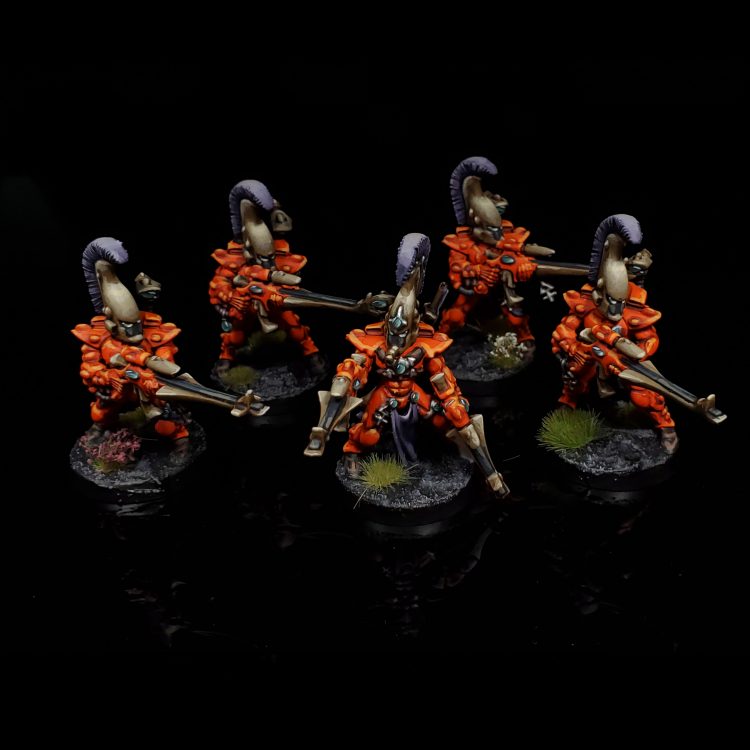
Craftworlds
Craftworlds return to a mixture of Guardians, Rangers, and Dire Avengers, but with a few twists. A Craftworlds Kill Team is made up of two Fire Teams, which are made up of:
- Four Rangers
- Four Dire Avengers
- Five Storm Guardians
- Five Guardian Defenders
If you don’t have a leader, you can replace one of the models in one of the Fire Teams with a leader type model, some of these are really good. Some less so.
Firstly, all Shuriken weapons have a rule called Rending, which basically means if you crit, you turn another hit into a crit. It’s nice, and it’s gonna let you do more damage with each of your attacks.
Rangers have pretty much a single load out, but it’s what you’d expect from a Ranger. A Sniper Rifle that hits on 2’s(!), does 3 damage and adds a mortal on a crit. However, the main bonus of Rangers are they can shoot without breaking Conceal (which makes them even harder to hit anyway), and if they’re in cover and DO get hit, their defensive cover bonus is doubled compared to normal. You just want to park these dudes and take pot shots for the whole game. If someone does get too close to them, you have a Shuriken Pistol, which is short ranged and less accurate, but does have that delicious rending. If they get into close combat, you’re probably boned. The leader can re-roll a single missed attack roll with their rifle, which is pretty neat, so take them if you don’t have a really good option.
Storm Guardians are… Storm Guardians, their close combat weapon is a straight upgrade to normal fists (+1 damage and +1 attack), but you’re here for the heavy weapons. The ‘con’ here is you can only take two heavy weapons total, one for each fire team. But they’re pretty good, though if they’re worth “taking 8 Storm Guardians as the rest of your Kill Team” is pretty debateable”. The Flamer is an absolutely brutal area of effect weapon, dealing 5 attacks that hit on 2s and do 2 damage regardless to a target within 6”, before proceeding to attack every other target within 2”. If someone clumps against this, they’re going to have a bad time. Meanwhile the Fusion Gun will just murder things. It does 6 damage base, 7 damage on a crit (4 of which are mortals!) and removes 2 of an opponent’s defense dice. So if you ever roll really, really hot, you’re doing 28 wounds, and ‘normally’ you’re looking at at least 12, which is enough to wreck most things, however, it’s got a pretty limited range. The leader isn’t good, try not to take them.
Dire Avengers are pretty nice, they’re armed with a Shuriken Catapult that can re-roll a single miss, and their Overwatch suffers no negative modifiers. They’re good. The Tactical Ploy First of the Aspects gives one of them an extra AP, which puts them at AP3, which is the blessed amount of AP, allowing you to move, shoot and do a Thing. The Exarch is what’s absolutely great here though. Their base catapult hits on 2s, or you can take two of them, losing that bonus but gaining both the ability to re-roll all their attack dice, or the ability to drop that, pay 2 CP and just shoot twice, which will mulch a whole lot of things. The Exarch was also a jerk and stole all the good close combat weapons, both your ‘free’ options lose out on taking a catapult, but they’re 4 attacks, hitting on 2s that deal 4 damage and crit on 5+, the Diresword hurts less than a power weapon when it crits, but it does have rending, so it’s a toss up (at least until the HoM article). Incidentally, you can spend some EP and take a Panoply, which are less accurate(?) fists that deal more damage. On the whole though, this Fire Team is good.
Defenders are in a strange spot, they’re strictly worse Dire Avengers, but they get the option to take a weapon platform instead of a Guardian. Some of the weapons on this platform are absolutely obscene, with the Bright Lance holding the title of “probably the strongest weapon in the entire game”. However, the main issue here is you can only take one person to crew the platform. They’re a pretty fragile Guardian (which can be concealed though), but if they die, the platform is just a giant paperweight, another Guardian can’t crew it, it’s just…there. In KT1 losing your Comms specialist was rather crummy, but in this, it’s just catastrophic.The Leader once again isn’t anything to write home about.
The Strategic and Tactical Ploys on offer are rather nice. With the characteristic “Free Dash” that Eldar like. Though the most interesting two are Supreme Disdain (if an opponent in melee has more failed hits than you, then you can turn a hit into a crit) and Hidden Paths (Rangers can basically dart between cover for free, like a game of whack a mole). As mentioned before, First of the Aspects is the coolest Tactical Ploy on offer. Equipment is also rather interesting as well, with the standout options being the Wraithbone Talisman (a free command re-roll once per battle), and the Ranger Scope (Long Rifle crits on 5+), incidentally, neither of these are capped.
Regarding the issue with Craftworlds in the old Kill Team, namely having to buy four different boxes to take two models from each one. That’s been completely fixed: Just buy two boxes of whatever you like and run that. The question now is whether we’re stuck waiting around for Aspects to release and whether we’ll see psychic stuff for Eldar in the future, but right now we have something functional that plays decently until we see what kind of bespoke teams the future holds.
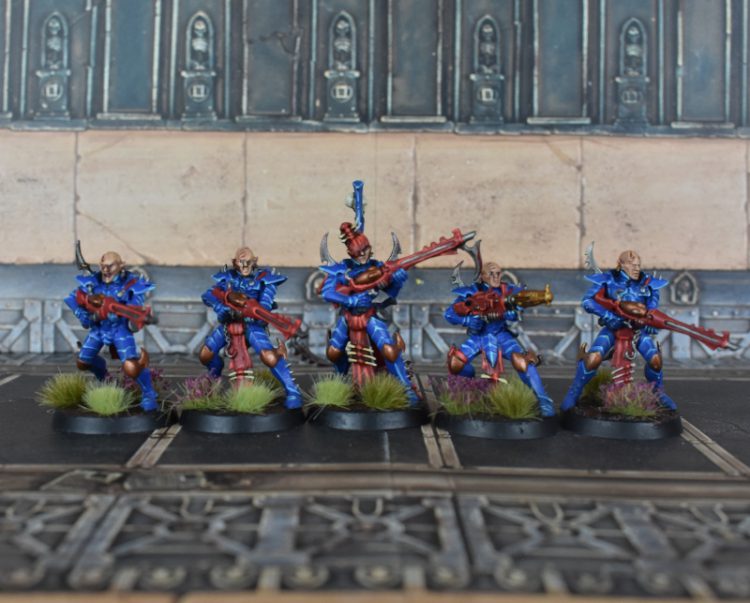
Commorites
A Commorite Kill Team is made up of two Fire Teams; you get either 5 Kabalites or 5 Wyches in each team, for a total of 10 models.
These have the focuses you’d expect – Kabalites are shooty, with options for a Gunner with blaster/shredder and Heavy Gunner with dark lance/splinter cannon (one Gunner per Fire Team, one Heavy Gunner per Kill Team, so no double dark lances!), and then the rest of the models consisting of Kabalite Warriors with splinter rifles. If you think that last bit sounds kind of anaemic, don’t worry – their poison is represented here by being Lethal 5+, which means that each of their 4 attacks crits on a 5+ instead of a 6! We should say that Kabalites are mostly shooty; as well as their guns they’re all equipped with an “array of blades” which gives them a fairly reasonable close combat weapon with Rending.
Wyches, meanwhile, can take two Fighters in a 5-model Fire Team, or 3 Fighters total per Kill Team (so if you double up on Wych Fire Teams you only get 3 Fighters, not 4).
There’s some clear influence here from the unit boxes; in particular, the Wych Fighters all have to have different weapons from hydra gauntlets/razorflails/shardnet and impaler, and the max of 3 per Kill Team conforms to the limits of what a single box of Wyches can get you.
You can pick either a Kabalite or Wych Leader, which both get a choice of gun (splinter pistol or blast pistol, or a splinter rifle for the Kabalite), and a choice of melee weapon (agoniser or power weapon; the Kabalite can instead keep his array of blades, and the Wych can alternatively take a hekatarii blade).
Commorites aren’t particularly tough, with just 8 wounds and either a 4+ or 6+ save, but they make up for it with high lethality. As mentioned, the basic splinter rifle crits for 4 damage on a 5+ attack roll; that gets even nastier when you consider blasters – 4 BS3+ attacks at damage 5 or 6 with AP2 – and dark lances – which can crit for as much as 7 damage per shot, enough to one-hit kill flimsier models and even threaten a Custodian’s impressive defences.
Wych Fighters offer similar damage potential, with razorflails a particular highlight with a mighty 5 attacks with Ceaseless (re-roll 1s on attack rolls), Brutal (your opponent can only parry with critical hits), and Reap 1 (which allows you on a crit to do a mortal wound to all other Visible enemy operatives within 1” of both your operative and the target). If you’re looking for something to dive in and inflict buckets of damage to a clustered enemy Kill Team, razorflails offer an excellent option to do just that.
Rounding out the team is a set of 4 Strategic and 2 Tactical Ploys, offering you options such as Agile Gladiators, an SP allowing your Wyches to turn enemy strikes into parries on a 4+ (i.e. stop them inflicting damage), as well as moving through other operatives, getting free climb/traverse/drop movement, and automatically passing jump tests. Alternatively, the Power from Pain TP allows you to immediately activate one of your operatives after incapacitating an enemy operative, adding a bonus APL and the ability to double shoot or double fight into the bargain.
Finally you have equipment options, a mix of grenades, Wych combat drugs, and ammo upgrades for Kabalites. Potentially spicy here are options to give splinter weapons Rending or Splash 1, or haywire grenades which become Lethal 4+ against targets with a Save of 3+ or better.
Commorite Kill Teams are going to live and die by their movement and positioning; they’re a relatively fragile team and a key operative being caught in the open and shredded by bolter fire is going to cause you serious problems. If they can close the gap, though, or isolate enemy operatives and hammer them with splinter and darklight fire, their ability to inflict massive damage should see them through.
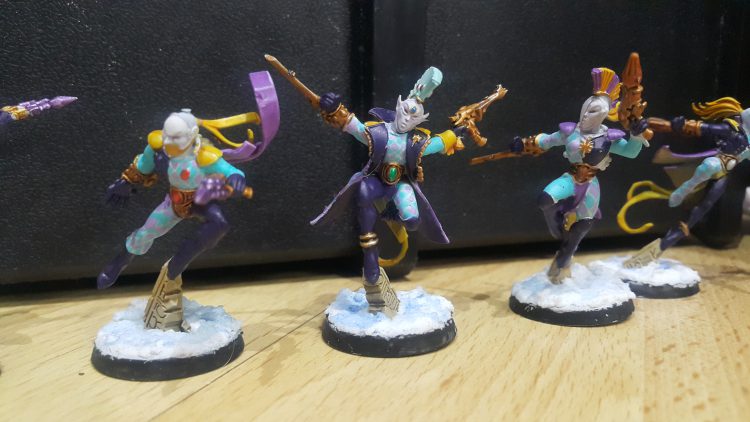
Troupes
Like the Grey Knights, Harlequins only have one Fire Team available to them, the Troupe. These do have the excellent distinction of having three categories of Tac Ops available to them – all of Seek and Destroy, Infiltration, and Recon – which immediately opens up some additional flexibility for them.
Every Troupe has a Troupe Leader who can take either a fusion pistol, shuriken pistol,or neuro disruptor, and any of the blade/kiss/caress/embrace or power weapon, and 7 Warriors with shuriken pistols and any of the Harlequin melee weapons. You can replace up to 2 Warriors with 2 Gunners who can take a fusion pistol or neuro disruptor plus the melee kit.
This immediately makes Harlequins a bit of an odd one out among these teams, as one of the few where you absolutely can’t build them from a single box – you will need at least two Troupes just to put enough bodies on the table. This suggests a mild sacrifice in the name of playability, since a team of 6 is probably too flimsy to stand up on its own.
The melee weapons are reasonably well distinguished from each other; standouts include the kiss which deals a measly 3 regular damage but a mighty 7 on a crit, and the blade which gets the Balanced trait allowing it to re-roll one attack dice. Fusion pistols are exactly as nasty as you’d expect – the base profile is slightly confusing with regular damage 5 and crit damage only 3, but then you notice that they do 3 mortal wounds on a crit too, which is overall much better.
Harlequins also benefit from a 4+ invulnerable save – a rare thing in Kill Team – and flip belts allowing them to count as having FLY and auto-passing Jump tests. Every Trouper has a mighty 3APL, too, allowing you to get a little more out of each activation.
Their Strategic and Tactical Ploys offer the kind of trickery you’d expect from this team – the Rising Crescendo SP allows your whole team to Dash and Charge while within Engagement Range of enemy operatives, and move an additional triangle while performing any of Normal Move, Fall Back, Dash or Charge, while the Heroes’ Path TP allows one operative to use an action that costs them all their APL for a turn but lets them redeploy anywhere on the table more than 6” from enemy operatives. The equipment list, on the other hand, includes some real delights like shrieker toxin rounds which give your shuriken pistol MW1, or accelerated monofilament wire which gives an embrace Lethal 5+ and Reap 1, upping its deadliness considerably.
Relative to some of the bigger factions Harlequins have a limited set of options, but they make up for it with high quality and a bag of tricks which lets them play the mission exceptionally well, while still being able to deliver brutal damage where required.
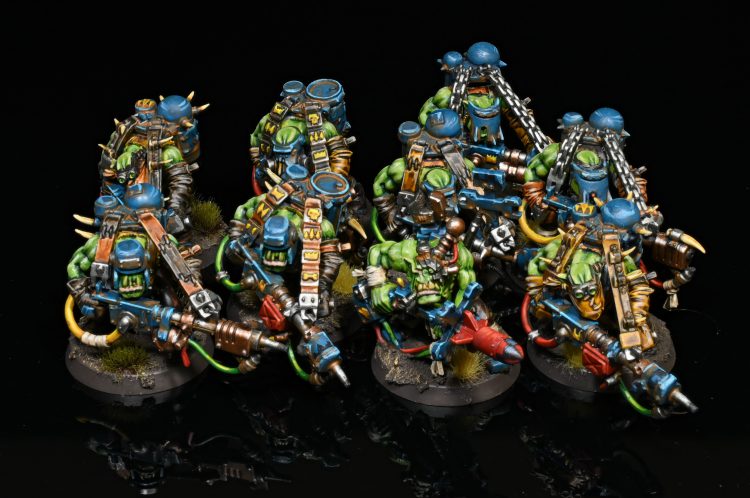
Greenskins
Oddly, Orks – or “Greenskins” as they’ve been labeled in the book (though their keyword is still “ORK”) – are both more and less versatile than the Kommando team from the Octarius Killzone. More versatile in that they have more unit options and can take larger teams but less in that they have fewer options overall and no faction TacOps yet. An Ork kill team consists of two fire teams from the following list:
- Boy
- Clan Kommando
- Speshulist
A Boy fire team includes five Boz with up to one Gunner, who gets either a big shoota or a rokkit launcha. You can also choose to trade out one boy in each boy fire team for a pair of gretchin. To make things as confusing as possible, the Clan Kommandos here are Kommandos like the Octarius ones, but also different. You get five of them, with the option to upgrade one to a leader nob if you didn’t take a leader elsewhere. Compared to the Octarius Kommandos these aren’t as unique, and just come with sluggas and choppas, while the Nob comes either a choppa or power klaw. Much less personality overall. And then there are the Speshulist fire teams. Each one contains four models in any combination of Burna Boys and Lootas and your optional leader upgrade here is a Spanner.
Stats-wise, Orks have poor BS but make up for some of it with a silly amount of attacks on their shooting; the standard shoota has 4 attacks, typically delivered at a BS of 5+ and like a bolter does 3/4 damage. Orks are significantly more menacing in melee however, where regular boyz with choppas have 4 attacks that hit on a 3+ and do 4/5 damage; enough to give space marines pause. Orks have bad saves but decent wound totals – boyz have 10 and nobz have 13 – and they’re still pretty fast, while their “heavy” weapons don’t slow you down since they lack the Heavy trait. A standard Ork team is likely to be 9-12 models, depending on speshulists and gretchin, and it’ll likely make sense to trade one or two boyz for some gretchin in most games so you can get the extra bodies. Gretchin have a group activation of 2, so you’ll be working with two of them at a time when you play.
Orks have a good number of ploys, and many of these match what the Kommandos get. Dakka! Dakka! Dakka! lets all your operatives turn one failed hit into a hit if they roll an critical hits when shooting, while Waaagh! lets you turn one of your hits into a critical hit when fighting in melee if you score 2+ hits. On the Tactical Ploys side, Just A Scratch is one of the more powerful or annoying tactical ploys, depending on who you ask, letting you spend 1 CP to ignore all the damage from a single attack dice when you fail a save, perfect for shoving a thumb in your opponent’s eye when they’re stacking effects to try and push through a critical hit or when you’re facing down the first hit of combat. And the Tactical Ploy More Dakka (1 CP) lets you shoot again with an operative against a target if you just shot at them and did no wounds. That’ll teach them to roll saves against you. The nerve. On the Equipment front, a couple of pieces overlap with Kommandos (stikkbombz, Bosspole) but for the most part these are totally different. Kustom Force Field (3 EP) is an interesting addition here to your Spanner operative, giving operatives wholly within 3″ a 5+ invulnerable save against shooting attacks.
Standard Ork teams have some decent options and variety and seem like they can be really nasty once they get in close, while occasionally getting lucky with shooting on the approach. That said, they aren’t nearly as interesting as Kommando teams, which play host to a ton of rules and sick models, so it’s an area where it’s hard to see why you’d play them over the Kommando option unless you really wanted burna boyz or lootas on your kill team.
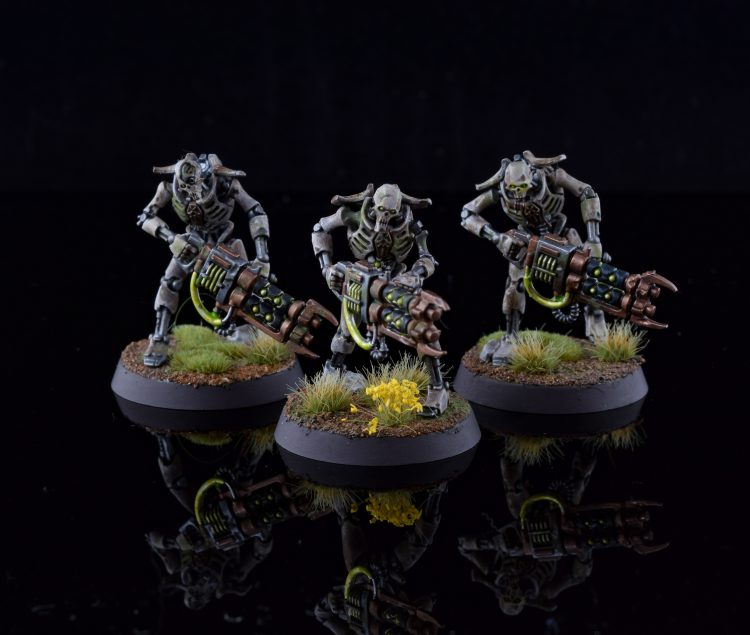
Tomb World
Necron Kill Teams are pretty straightforward, giving you two fire teams to pick from a list of:
- Five Necron Warriors (max 1)
- Four Immortals
- Five Flayed Ones
- Four Deathmarks
Otherwise the key feature of Necron kill teams is Living Metal, an ability all the team’s models share that gives them the ability to regain up to 2 lost wounds every turn during the Ready Operatives Step. Combine this with decent saves and 9-10 wounds on each model and Necrons can really make you regret not finishing them off. On top of that the Reanimation Protocols (1 CP) Tactical Ploy, which you use when an operative dies to give them a chance to get up at the start of every turn following on a 3+ (or a 2+ for warriors). You can only have this active for one operative at a time, but dropping it on your first downed operative each game is a pretty good play since odds are good you’ll be back up in a turn or two, especially if you’re going with a warrior (and the 2+ roll is the most compelling reason to bring them).
Necrons are otherwise like in-between units for Guard and Space Marines. They only have 2 APL and they’re slow (4” movement), but they have more wounds and better saves, and Immortals and deathmarks have better shooting – Gauss Blasters being 4 shots hitting on a 3+ with 4/5 damage and AP1 is pretty solid. And you can mitigate some of their speed with the Implacable March (1 CP) Strategic Ploy, which gives you the option of taking +2” of movement but only lets you do normal move, shoot, charge, and fight actions for a turn – great for turn 1 when you may not yet be in range of objectives. Warriors are a bit less sturdy, though per above are more likely to reanimate in a pinch. Almost all of the Necron operatives tend to favor shooting save the Flayed Ones, whose 5 attacks with WS3+ and 3/4 Rending damage can be particularly nasty, though they’re just as slow as the rest of the Necrons, and only having 4″ movement is pretty bad for a melee-only operative. The good news is that they can use Implacable March like the rest, and Flayed Ones have access to the Skulking Killer Strategic Ploy, which allows them to Charge while Concealed.
Necron Equipment is limited but essentially lets you double down on giving your operatives a bit of extra shooting power or some melee prowess in a pinch. Starfire Core lets you retain an extra hit in shooting if you score any crits, while Hyperphase Blade gives your bayonet the Lethal 5+ rule, doubling your chances of a crit in melee. On the whole Necrons are a slow, deliberate force that can really make you regret it if you don’t finish them off one at a time. They can also surprise you with some extra moves early on and the Deathmarks can be appropriately sneaky, changing their orders for 1 CP with Dimensional Concealment.

Hunter Cadre
Tau in Kill Team two will be an entirely different force to reckon with compared to the previous incarnation. Made up two fire teams consisting of either
- six Fire Warriors – which covers both Strike and Breacher weapons.
- six Pathfinders
- 3 Stealth Battlesuits.
You can swap out a Fire Warrior or Pathfinder for a single Drone, or swap a Stealth Battlesuit for 2 Drones. So far this seems pretty recognisable to what Tau might have fielded in KT18, there’s a few key limits that will lead to vastly different Tau kill teams though.
- Each type of drone can be included once in the Kill Team, so that’s a max of 1 Shield Drone for instance.
- On the subject of Drones most of the special drones are available, such as Guardian or Grav-Inhibitor, but you must swap a Fire Warrior or Pathfinder for them respectively. Similar to bringing them in a 40k army. DS8 Turrets are also a Drone in KT21 and are included in the same way.
- Rail Rifles, a staple of Tau forces previously, are limited to one per Pathfinder fire team.
It’s Tau though so lets address the elephant in the room, how Saviour Protocols work in KT21. Well it’s better, at least in my opinion, for both sides. A Drone can have their Saviour Protocols activated when a friendly operative within 2” is selected as a target of a shooting attack. From activation until the end of the turning point that drone is now protecting that single operative, and no others. This protection comes in the form of forcing all attacks on that operative to instead target the protecting drone, even if the drone isn’t a valid target (for being out of sight or range perhaps). When taking attacks in this way Drones can’t benefit from cover. There’s some quirks in the wording that could lead to arguments about the ability continuing to work even if the drone dies, but I personally feel the core rules cover this and that they can’t (see a future Ruleshammer on this). Drones also have a few limits and clarifications that I feel are worth mentioning, firstly you may have noticed that they don’t have heads. There’s a whole diagram covering what to use instead in the book, the domed top of the disk is used instead. They also can’t pick things up, and they count as 1 APL less for objective control.
Markerlights are Tau’s unique action in this edition costing 1AP. Pathfinders are equipped with them by default. Warhammer Community somewhat confusingly debuted the benefit of Markerlight tokens but not how they are given to enemy targets. It’s essential 1AP for a unit with a Markerlight to give that operative a token, no hit rolls required. If that operative shoots in the same activation then it must be the same target for both. The benefit is as previewed, targets with any number of tokens can have a single attack dice re-rolled each time a shooting attack is made (so that’s one dice of however many you are rolling for that attack). There doesn’t appear to be any benefits to multiple tokens
Now lets highlight a few of the toys Tau have to use:
- Rail Rifles are brutal in this edition, having a special rule called Lethal that allows them to do Critical hits on a 5+ to hit, and their Critical hits do 2 Mortal Wounds. They also have AP1. This guns will put the hurt out at range.
- Fusion blasters like most Melta-styled weapons in the game are also very devastating, capable of 4MW on a Critical Hit. What I think will really help these though is that Tau have a Tactical Ploy named Stand and Fire (1CP) that allows them to use a ranged weapon in melee. It does disable the special rules though, but AP2 doesn’t affect melee fighting anyway. They’re still capable of the 4MW for a critical hit though!
- Many drones and their abilities, Guardian Drones have an action to provide a 5+ invulnerable for all Tau operatives within 4”, this does mean they need to be activated each turn though. Grav-inhibitors have both a defence passive ability against units charging near them, and an action to help friendly units Fall Back. There’s a lot more too!
Honestly these Fire Teams are in my opinion really well balanced, and this review only scratches the surface of their ploys and equipment options. The only quirk I can’t figure out is Carbines. They’re completely identical to Pulse Rifles in KT21, and whilst Pulse Rifles and Pulse Blasters both have tactical ploys to benefit from, Carbines have nothing. There is no reason to use them on a Fire Warrior.
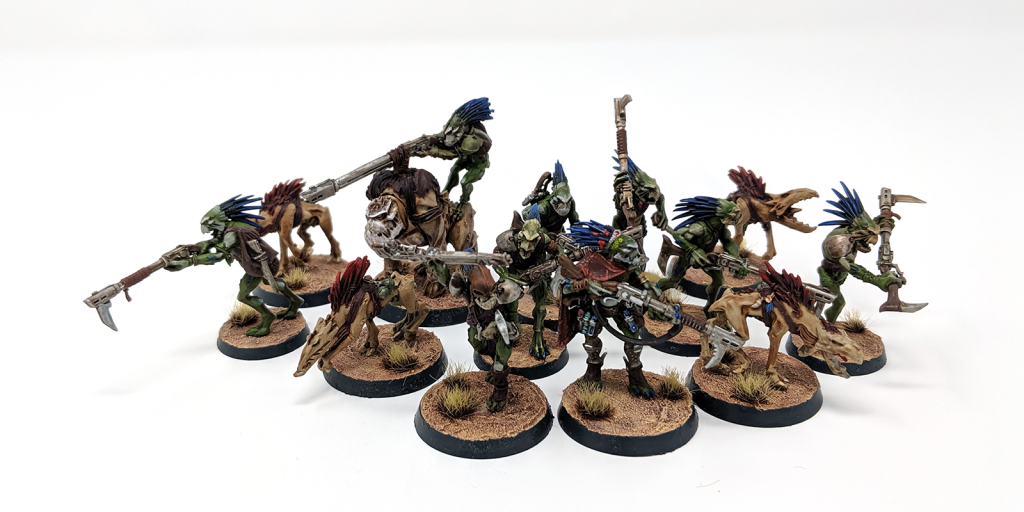
Cadre Mercenary
It’s time for Kroot again, a late inclusion in KT18 that struggled due to not having any heavy or special weapons, or much in the way of punch if you didn’t take a Krootox. This time around you get thirteen Kroot (so you can horde it up) but can swap two Kroot for a Krootox and up to four Kroot on a one-for-one basis to Kroot Hounds. Kroot come with kroot rifles, which hit as hard as a bolter, and rifle blades which hit the same as a standard marine or chaos marines fists. Their save jumps from 6+ to 4+ if they are in cover, so the best thing to do is dash from cover to cover and be a good deal more survivable, even if you’re keeping them in Engage mode.
Taking a Krootox is worth it for a large high wound model with a high damage gun and a Brutal close combat attack that can hit up to 5 times with the Brutal rule, plus the Krootox doesn’t need to be in cover for the 4+ save and has 16 wounds. Kroot Hounds are fast with a Rending close combat attack, but I think as a player you should experiment with how many you take and whether it suits your play style. Maxing them out may not be the play, though it can also depend on the opponent and how much extra speed you’ll need – Kroot Hounds are among the fastes operatives in Kill team with an 8″ move, which means with a dash they can cover 11″ per turn or 10″ on a charge.
Where Kroot are really going to shine are their ploys. The Patient Stalkers (1 CP) Strategic Ploy lets any of your operatives charge while they have a Conceal order, ensuring you can get the drop on an opponent who hasn’t had a chance to shoot you yet, while Fieldcraft (1 CP) gives every one of your Carnivore operatives the ability to spend 1 AP to change their order, allowing you to swap to Engage, shoot something, then pop back into Conceal. And Perfect Ambush (1 CP) is a Strategic Ploy that lets you change the order of any operative when it’s activated during the first turning point, allowing you to start your entire team in Conceal then push them to Engage as needed to shoot or charge on turn 1. It’s almost always going to be your turn 1 play. Kroot don’t have a ton of wounds, but with the Tactical Ploy A Gory Feast (1 CP) they can eat n operative they’ve killed in melee to get +1 APL and regain D6 lost wounds.
On the Equipment side, Kroot have some nifty upgrades but they’re expensive enough that you won’t take too many. That’s OK – your primary play will be playing around with your orders to hit your opponent without being hit back. Kroot may struggle with mission primary objectives as a result, particularly if those objective markers are out in the open. But on the whole the team has some of the cooler tricks of any of the Compendium teams and I’m kind of into the idea of playing them.
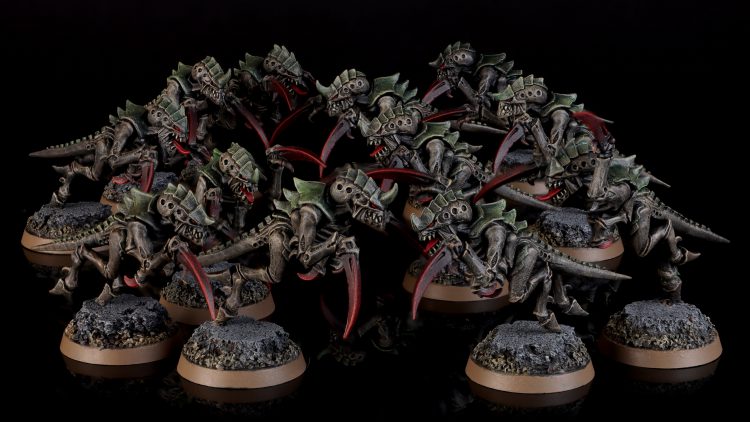
Credit: Pendulin
Hive Fleet
Tyranid Hive Fleets are an interesting and flexible mix of Tyranid models, albeit missing some arguably important choices and traits. A Hive Fleet kill team is composed of two of the following choices:
- Tyranid Warrior,
- Genestealers
- Tyranid Swarm (limit 1).
The Tyranid Swarm option offers a mixed selection of Termagants and Hormagaunts. For balancing purposes, players can elect to trade two operatives for one termagant armed with a devourer. If you’re planning on going with a swarm, this is probably a decent trade for the first couple operatives as the devourer is one of the more potent ranged weapon options but the fragility of termagants is such that you’ll want to keep “standard” swarm models around for good board coverage.
Something that players will quickly come to realize with Hive Fleet operatives is that the playstyle is much more inline with other Kill Team factions–you cannot plan to overwhelm your enemy with force in the traditional 40k way. The range of operatives and the numbers you’re given per fire team simply isn’t enough to comfortably outnumber/outmaneuver other teams and each of your operatives–even the Warriors–are relatively squishy. There’s always going to be an exception, but for most matchups Hive Fleet teams will be much more effective playing to stealth. The ploys available can be very useful, but obviously with such a limited CP budget your applications will only get you so far.
It’s been discussed in the general Kill Team review, but leaning too heavily into melee is going to result in some sour gameplay. Genestealer fire teams especially are best applied to objectives, sticking to conceal order and only ever swapping into engage when you can achieve a surefire kill. The free dash genestealers receive can often be very useful to edging around terrain and getting into position for mission actions, but note that there is no exception limiting charging on the same activation. Inappropriate targets, such as a healthy space marine, are going to put a ton of damage into your fragile fighters and with a lucky roll leave you frustrated with a dead ‘stealer.
Typically it’s not going to be an issue but something that’s noticeably absent is Shadow of the Warp, which has been a mainstay aspect of Synapse for ages. There’s a number of factions that contain psykers and if you’re getting doombolt’d you might find yourself asking why this doesn’t exist. It’s likely the designers just couldn’t make the mechanic work around how they set up psychic powers here; for a faction that’s already pretty light on defense, losing a familiar defensive trait is aggravating.
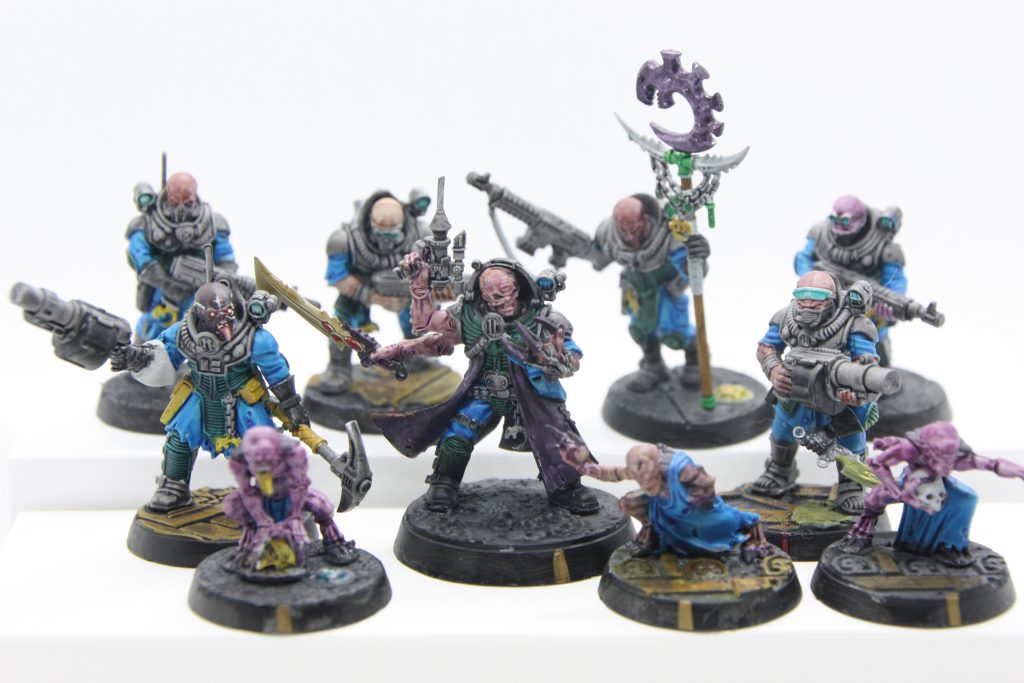
Brood Coven
Genestealer Cults teams have finally graduated beyond packing purestrain genestealers in this release, and can pick two fire teams from the following:
- Neophyte Hybrids (7 operatives)
- Acolyte Hybrids (5 operatives)
- Hybrid Metamorphs (5 operatives)
Each team has some specialist options; Neophytes are your shooters, since they’re able to take 2 gunners (with flamer, grenade launcher, or webber) and one heavy gunner (with heavy stubber, mining laser, or seismic cannon), while Acolytes and Metamorphs are more melee-oriented, with the former getting access to up to two Fighters with rock cutters, drills, or saws and the latter getting access to incredibly nasty melee weapons in the form of Metamorph Mutations. A balanced team for Genestealer Cults likely wants a Neophyte fire team and one of the other two; Acolytes have access to heavier melee weapons with their various rock-destroying tools but the metamorph mutations are nearly as nasty and you get them on every model in the metamorph group, so the one you’ll want to take is likely going to come down to personal preference. There isn’t a ton of difference between the different hybrids stats-wise, though leaders get access to a few more weapon options and can be better at fighting compared to their brethren.
So in a lot of ways the Genestealer Cults play like a sneaky melee team with some ranged support. They aren’t quite big enough to be horde-like unless you double up on Neophytes but that’s likely a mistake most of the time. They get some support for their sneaky strategies from Strategic Ploys that let them change their orders upon activation during the first turn and another that lets them double up on the benefit of cover – Lurk in the Shadows is a 1 CP Strategic Ploy that lets you either take an additional normal save when in Cover or retain one die as a free critical save. Both are very useful and you can pick after you see the attack dice. On the Tactical Ploys side, Lying in Wait (1 CP) lets you activate another operative immediately after the current one if used on an operative in conceal , while Into the Shadows lets you change your order to Conceal, leading to some interesting combos. And Underground (1 CP) is used during set up to drop one of your operatives anywhere on the table in heavy cover more than 6″ from an enemy model or the enemy drop zone.
Overall Genestealer Cults feel like a tricky finesse team with some nasty melee fighters ready to mess you up if you let them get too close. Metamorphs especially are likely to feel like glass cannons and so making good use of a GSC kill team will mean making great use of cover and the ability to continually drop back into conceal orders. They certainly stand to be one of the more interesting teams in the book.
How Do These Teams Stack Up?
Generally speaking, the games we’ve played with these teams feel very balanced. There’s a lot of back-and-forth, and the heavy hitters with the high wound values tend to feel properly offset by either slow movement, small numbers, or both. The action economy with APL also feels spot-on, as smaller teams can compete with larger ones by having a better action economy without feeling too constrained. Missions also help on this front; teams with more models have a natural advantage in many ways but the Overwatch mechanic helps balance this out as well.
If there’s an early frontrunner for the faction which we expect to become known as a fucking nightmare, Harlequins are it. 3APL everywhere gives the team a lot of stuff they can do, they ignore most of the rules, play the mission really well, and can absolutely batter enemy operatives off the table. They don’t even have particularly low numbers; their 8 operatives with 3APL compares very favourably to teams of 10 with 2APL in terms of actions per turn, while they comfortably outnumber other “elite” teams . We’ll see how it goes as more games start getting played, as maybe it’ll turn out that they’re tamer than we think, but the initial signs point to them being A Lot.
Otherwise, these are some good rules. There’s some weird quirks here and there, but mostly you should be able to pick the faction you prefer, get to the table and have a satisfying game using them. In a lot of ways I think the Compendium teams might be better for intro games than the Octarius teams, since most of them have less going on.
What’s Not in Here
The most obvious things can be seen by contrast to what’s in the Octarius campaign supplement in the Core Box. There’s no faction-specific Tac Ops, for example, nor are there any unique campaign rules like the Battle Honours or rare equipment available to Veteran Guardsmen and Kommandos.
There’s also no sign of Commanders, and a distinct lack of some units that you would kind of expect – Terminators stand out here, but also Aspect Warrior-based Fire Teams (except Dire Avengers) in Craftworlds, for example. Neither are there subfaction traits; subfactions are foregrounded in the rules, with e.g. <CHAPTER> or <KABAL> keywords on datasheets, but right now they don’t do anything. Commanders didn’t exactly set the game on fire in the first iteration of the game, and we’re keen not to return to Space Marines having more datasheets for Kill Team than most factions have in full-size 40k, but it would be surprising not to see a few more options added in future publications.
What Does This Say About the Future of Kill Team?
Much like the 8th edition 40k indexes or the faction rules in the KT 2018 rulebook, the Compendium is very clearly a set of “get you by” rules intended to allow you to take models from Kill Teams or 40k armies that you already own and get them slamming on the table. This isn’t intended as a criticism; the teams in the book have reasonably developed suites of options, and the way the game works means that they can be very distinct from each other just on the basis of their basic profiles and wargear – even just having 3APL vs the ordinary 2 allows your elite models to feel properly high-speed low-drag.
That said, there seem like some obvious courses of action here. It would be utterly unsurprising to see:
- Expanded rosters with more Fire Teams for popular options conspicuous by their absence
- Rules for subfactions
- Additional Spec Ops rules, with new rare equipment, assets for your base, battle honours, and requisitions
The more interesting question here is what form these take. Games Workshop has in many ways put most of this question to bed in the short term with their recent Kill Team road map, which shows that we’ll get new warzones and kill teams in each of Q4 2021 and Q1 2022. Far from being an Elites-like expansion, these instead suggest that the future is more specialist Kill Teams like the ones in the Octarius box, likely packaged together with some terrain for the killzone.
This is a mixed bag for players. On the one hand, it seems more likely that the teams in the Compendium are as complete as they’re going to get. Which is fine – these teams are adequate, give you lots of options, and are easy for beginners to pick up since they ensure your box purchase gives you a playable team. On the other hand, it does mean we’re less likely to ever get Terminators, Chaos Cult Marines, or some of the other crazy stuff outside of a much more constrained team. That’s OK, particularly if GW makes the (in my opinion, smart) decision to publish full rules for older teams in future issues of White Dwarf. There’s some natural fits here: GW, if you’re reading this, give us rules for Gaunt’s Ghosts, Kill Team Cassius, Elucidian Starstriders, Gellarpox Infected, and some of the weird Blackstone stuff.
Final Verdict
While the teams in here aren’t as detailed as the ones in Octarius rules-wise, there’s a ton here and almost all of it feels very well-balanced. There aren’t any glaring omissions from a faction standpoint this time around, and if you’re going to play Kill Team 2.0 with anything but the Octarius teams, you need this book. It’s all crunch, no fluff and I’m not sure there’s a truly bad team in the book.
Have any questions or feedback? Drop us a note in the comments below or email us at contact@goonhammer.com.

